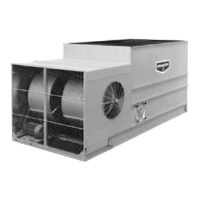18
Operation and Maintenance Instructions
If a chemical water treatment program is used, the chemicals selected must be compatible with the unit materials of construction as
well as other materials used in the system. The chemicals must be accurately metered and concentrations properly controlled.
Chemicals should be introduced through automatic feeders at a point in the system where total mixing can occur before reaching
the evaporative cooling equipment. Chemicals should never be batch fed directly into the unitʼs basin or water distribution system.
The use of acid should be avoided. If acid cleaning is required, only inhibited acids recommended for use with the unitʼs materials
of construction should be used.
Passivation of Galvanized Steel
Passivation is the formation of a protective zinc carbonate layer on galvanized steel. The zinc carbonate layer protects the
galvanized surface by sacrificing itself slowly over time. This layer can be diminished by walking on the surface or by pressure
washing.
Heavy mill galvanizing provides an excellent corrosion resistant barrier for the substrate steel on an evaporative cooling unit. The
zinc finish is a reactive metal which acts as a sacrificial anode to protect the steel substrate. Units that are operated within the
recommended pH levels of 6.5 to 8.3 and are passivated allow a surface barrier of non-porous zinc carbonate and zinc hydroxide
to form which prevents rapid galvanic corrosion. This basic zinc carbonate barrier must be allowed to form in order to provide
maximum protection for the mill galvanized steel.
Steel mills producing galvanized steel perform a passivation wash after processing the steel. This mill applied passivation is
only a temporary passivation program. The unit must be passivated during the unit start up phase and must be part of the
water treatment program. Passivation of the galvanized steel surface is critical to prevent the formation of “white rust”
and to extend the life of evaporative cooling equipment.
To prevent the formation of “white rust” (porous zinc carbonate cells), the interior of the unit must be passivated during start up and
monitored periodically as part of the water treatment program. A qualified water treatment program should be designed to inhibit
zinc corrosion while maintaining chemical concentrations within recommended levels. Since re-passivation may be necessary
during normal operation, the water treatment program should be continually monitored.
The passivation program should operate for a period of 45 to 60 days. The pH of the circulating water must be between 7.0 and
8.0; hardness measured as CaCO3 should be between 100-300 ppm; and alkalinity measured as CaCO3 should be between 100-
300 ppm.
If white zinc deposits form on the galvanized steel surfaces after the pH is returned to normal operating levels, it may be necessary
to repeat the passivation process. These deposits should not be removed with pressure washing, wire brushing or by any other
mechanical means. See Section titled “White Rust” for more information.
White Rust
White rust is defined as “the rapid formation of non-protective zinc carbonate cells on the surface of galvanized steel”. These
deposits appear as white powdery cells and are considered to be a zinc corrosion by-product. These cells are porous and allow
continued corrosion of any non-passivated galvanized steel surface. This type of corrosion is most prevalent in the wetted areas
of evaporative cooling products. Water chemistry that promotes the formation of “white rust” includes:
1. pH levels greater than 8.3
2. Calcium hardness as CaCO3 less than 50 ppm
3. Anions of sulfates, chlorides and nitrates greater than 250 ppm
4. Soft water with calcium hardness (CaCO3) less than 50 ppm combined with a high alkalinity greater than 300 ppm
(CaCO3) and a pH greater than 8.3
It should be noted that not all white deposits found on galvanized steel surfaces are due to white rust. As a result, it is imperative to
determine the inorganic content of the deposit. The deposits may be calcium based and not zinc based.
For more information, please request a copy of EVAPCOʼs Engineering Bulletin 36 on White Rust.

